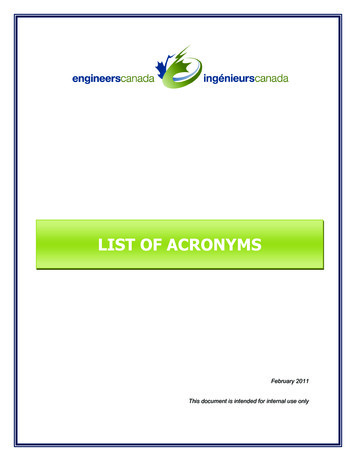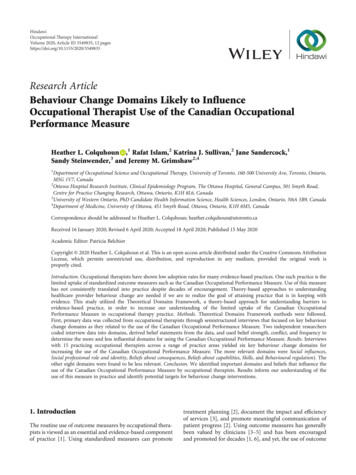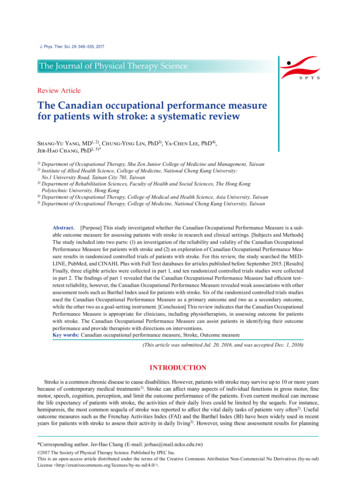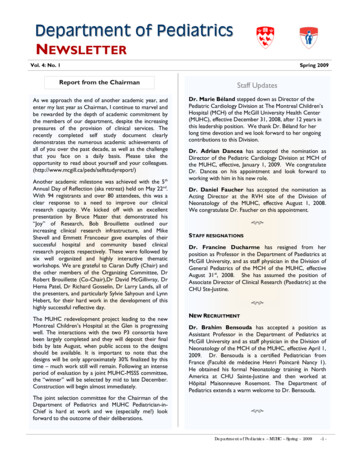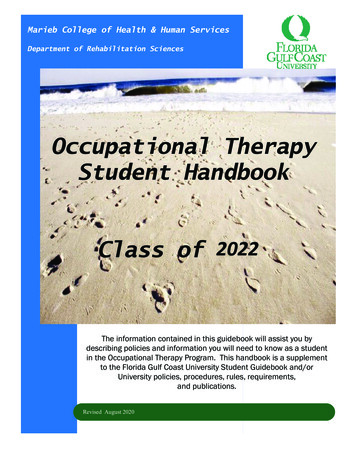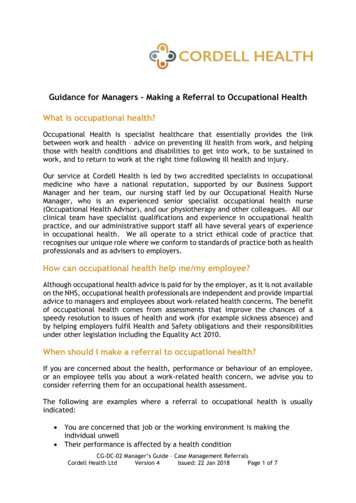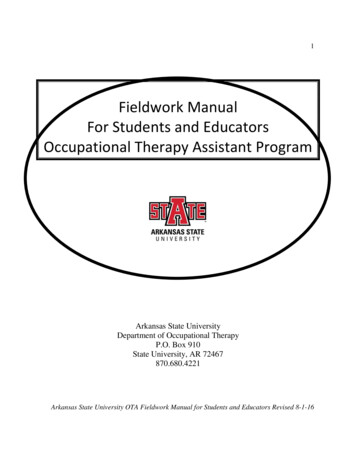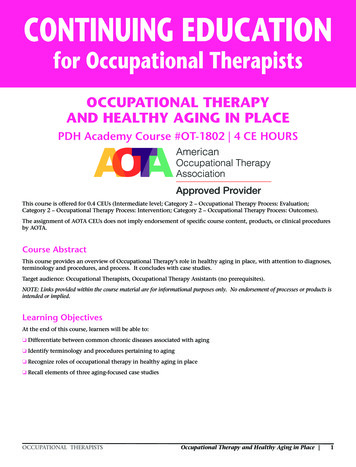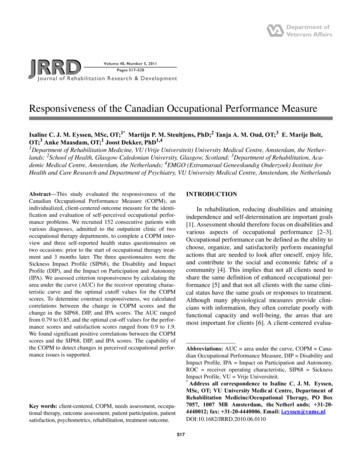
Transcription
JRRDVolume 48, Number 5, 2011Pages 517–528Journal of Rehabilitation Research & DevelopmentResponsiveness of the Canadian Occupational Performance MeasureIsaline C. J. M. Eyssen, MSc, OT;1* Martijn P. M. Steultjens, PhD;2 Tanja A. M. Oud, OT;3 E. Marije Bolt,OT;3 Anke Maasdam, OT;1 Joost Dekker, PhD1,41Department of Rehabilitation Medicine, VU (Vrije Universiteit) University Medical Centre, Amsterdam, the Netherlands; 2School of Health, Glasgow Caledonian University, Glasgow, Scotland; 3Department of Rehabilitation, Academic Medical Centre, Amsterdam, the Netherlands; 4EMGO (Extramuraal Geneeskundig Onderzoek) Institute forHealth and Care Research and Department of Psychiatry, VU University Medical Centre, Amsterdam, the NetherlandsINTRODUCTIONAbstract—This study evaluated the responsiveness of theCanadian Occupational Performance Measure (COPM), anindividualized, client-centered outcome measure for the identification and evaluation of self-perceived occupational performance problems. We recruited 152 consecutive patients withvarious diagnoses, admitted to the outpatient clinic of twooccupational therapy departments, to complete a COPM interview and three self-reported health status questionnaires ontwo occasions: prior to the start of occupational therapy treatment and 3 months later. The three questionnaires were theSickness Impact Profile (SIP68), the Disability and ImpactProfile (DIP), and the Impact on Participation and Autonomy(IPA). We assessed criterion responsiveness by calculating thearea under the curve (AUC) for the receiver operating characteristic curve and the optimal cutoff values for the COPMscores. To determine construct responsiveness, we calculatedcorrelations between the change in COPM scores and thechange in the SIP68, DIP, and IPA scores. The AUC rangedfrom 0.79 to 0.85, and the optimal cut-off values for the performance scores and satisfaction scores ranged from 0.9 to 1.9.We found significant positive correlations between the COPMscores and the SIP68, DIP, and IPA scores. The capability ofthe COPM to detect changes in perceived occupational performance issues is supported.In rehabilitation, reducing disabilities and attainingindependence and self-determination are important goals[1]. Assessment should therefore focus on disabilities andvarious aspects of occupational performance [2–3].Occupational performance can be defined as the ability tochoose, organize, and satisfactorily perform meaningfulactions that are needed to look after oneself, enjoy life,and contribute to the social and economic fabric of acommunity [4]. This implies that not all clients need toshare the same definition of enhanced occupational performance [5] and that not all clients with the same clinical status have the same goals or responses to treatment.Although many physiological measures provide clinicians with information, they often correlate poorly withfunctional capacity and well-being, the areas that aremost important for clients [6]. A client-centered evalua-Abbreviations: AUC area under the curve, COPM Canadian Occupational Performance Measure, DIP Disability andImpact Profile, IPA Impact on Participation and Autonomy,ROC receiver operating characteristic, SIP68 SicknessImpact Profile, VU Vrije Universiteit.*Address all correspondence to Isaline C. J. M. Eyssen,MSc, OT; VU University Medic al Centre, Department ofRehabilitation Medicine/Occupational Therapy, PO Box7057, 1007 MB Amsterdam, the Netherl ands; 31-204440012; fax: 31-20-4440006. Email: i.eyssen@vumc.nlDOI:10.1682/JRRD.2010.06.0110Key words: client-centered, COPM, needs assessment, occupational therapy, outcome assessment, patient participation, patientsatisfaction, psychometrics, rehabilitation, treatment outcome.517
518JRRD, Volume 48, Number 5, 2011tion of occupational performance, i.e., with the CanadianOccupational Performance Measure (COPM) [7], canhelp account for individual changes.The COPM is an outcome measure designed to helpclients identify, prioritize, and evaluate important issuesthey encounter in occupational performance [7]. Thisindividualized outcome measure is used to assess a client’s self-perception of actual performance and satisfaction with this performance over time. The assessment isconducted with a semistructured interview format and astructured scoring method and aims to assess change in aclient’s self-perception in occupational performance overtime [7]. The conceptual basis of the COPM is derivedfrom the Canadian Model of Occupational Performance,which is now extended to the Canadian Model of Occupational Performance and Engagement [4,7–8].The clinimetric properties of the COPM have beenstudied in various situations. The reproducibility of theperformance and satisfaction scores was found to be poorfor the individually identified problems and moderate tohigh for the scores averaged over all the problems identified by a client [7,9–13]. Supportive evidence was foundfor the content, convergent, and divergent validities ofthe COPM [2,7,9,11,13–18]. Clinical utility, evaluated ina number of different studies, supported the use of theCOPM for a variety of clients in different settings[13,17,19–26]. The COPM is designed to not only identify the client’s perceived problems but also determinewhether these problems have changed over time. Thecapability of a measure to detect change over time isreferred to as its responsiveness [27–28].The difference between validity and responsivenessis that validity refers to the validity of a single score andresponsiveness refers to the validity of a change score[29]. As a logical consequence, criterion and constructresponsiveness can be defined analogous to criterion andconstruct validity [29]. Criterion responsiveness isdefined as the extent to which change in scores on a particular instrument relates to change in the gold standard.Construct responsiveness is defined as the extent towhich change in scores on a particular instrument relatesto change in other measures.Various approaches exist for measuring responsiveness [28–32]. Inappropriate measures of responsivenessare the use of effect sizes and related measures such asstandardized response mean and relative efficacy statistics [33]. A suitable method to assess responsiveness iscalculating change scores for clients whose health isexpected to have changed and to examine the correlationwith corresponding changes in a reference measure ortransition indices [30–32].Several studies have indicated that the COPM is sensitive to change [2–3,7,12–13,20,34–35]. However, some ofthese studies are unpublished [7], used no criterion standard [3,7], or focused on a small study population [12,34]or specific diagnoses [20,34–35]. Therefore, the responsiveness of the COPM needs to be further evaluated.The main objective of the present study was to evaluate the responsiveness of the COPM in a population ofoutpatients receiving occupational therapy interventions.Our evaluation was based on two research questions:1. To what extent is the COPM able to detect improvement over time (criterion responsiveness)?2. To what extent do changes in the COPM correlate withchanges in other measures (construct responsiveness)?Additionally, we evaluated the feasibility of theCOPM and the correlation between the satisfaction andperformance scores of the COPM.METHODSStudy Population and AssessorsWe recruited consecutive clients with various conditions who were newly referred to the outpatient occupational therapy departments of the Academic MedicalCentre and the VU (Vrije Universiteit) University Medical Centre in Amsterdam. All clients received oral andwritten information about the study. Our intent was toinclude 150 clients, 75 in each center.Inclusion criteria were 18 years or older, perceivedlimitations in more than one activity of daily living, andan outpatient treatment indication for occupational therapy. Clients who were currently receiving occupationaltherapy or had insufficient understanding of the Dutchlanguage were excluded. Written informed consent wasobtained from all participants.Four assessors, two in each hospital, collected thedata. They were all occupational therapists trained inadministering the COPM. The assessors were not involvedin the therapy sessions; the assessments were performedindependently from the provided occupational therapy.InstrumentsThe official Dutch translation of the COPM was used[36]. With the COPM, the therapist helps the client identify
519EYSSEN et al. Responsiveness of COPMactivities that the client “wants, needs, or is expected toperform” [7] and in which the client experiences problemswith the actual performance or is dissatisfied with the levelof performance. Accordingly, the client prioritizes up tofive problems that are the most urgent or important andrates each of these problems on an ordinal 10-point scaleregarding performance (where 1 “not able to do it at all”and 10 “able to do it extremely well”) and satisfaction(where 1 “not satisfied at all” and 10 “extremely satisfied”). We obtained the mean scores for performance andsatisfaction by summing the ratings for performance andsatisfaction over the prioritized problems and dividingthem by the number of prioritized problems. For an evaluation over time, at a later date the client again rates the performance and satisfaction regarding the prioritizedproblems of the first COPM interview. Mean scores can becompared with the mean scores of the first COPM.To assess the criterion responsiveness, we used a transition index [37–38] to measure the perceived change inthe problems as prioritized by the COPM. The perceivedchange in problems was graded on a 7-point ordinal scale,where 1 “totally diminished” and 7 “much worse.”The transition index was pretested in a small group (n 10 outpatients) and did distinguish between improved andunimproved patients. Patient-reported health transitionquestions that describe the magnitude and direction ofchange in general or specific health over a given periodare a valid approach to measuring change and have beenwidely used as external criteria in the evaluation ofresponsiveness [38–39].We assessed the construct responsiveness by comparing the COPM scores with the scores for the SicknessImpact Profile (SIP68), the Disability and Impact Profile(DIP), and the Impact on Participation and Autonomy(IPA). All these instruments include scales and/or subscales on the activities and participation domain of theInternational Classification of Functioning, Disabilityand Health [40] and aim to measure the impact or importance of a condition on functioning.The SIP68, a generic measure used for assessing theimpact of illness on daily functioning and behavior [41–42], consists of 68 items that are all dichotomouslyscored. The items are categorized into six subscales:somatic autonomy (e.g., getting dressed, transfers),mobility control (behavior related to walking and armfunction), psychological autonomy and communication(e.g., concentration, alertness, talking), emotional stability (the effect of health status on emotional behavior),social behavior, and “mobility range” (instrumental dailyactivities). Subscale scores and an overall score can becalculated from the number of confirmed sickness impactitems. The SIP68 is a reliable instrument and a valid discriminative method able to detect changes in healthrelated functional status [41].The DIP is a self-administered questionnaire concerning activities that may be restricted because of a disabling disease [43–44]. It consists of 39 questions aboutsymptoms (3 items) and the five domains: mobility (10items), self-care (6 items), social activities (10 items),communication (5 items), and psychological status (5items). Every question is rated on a 0- to 10-point scalefor the current level of disability (0: maximal disability,10: no disability) and for the importance (impact) of thatparticular disability (0: not important at all, 10: mostimportant of all). The validity of the DIP is satisfactory[44–45] and its reliability is acceptable [46].Weighted scores are calculated by determining thedeficit from the normal situation by subtracting the actualdisability score from 10 and multiplying this deficit bythe impact score for that item. This calculation results ina combined deficit score that is divided by 100. Thisvalue is then subtracted from 1. The result is a weighteditem score, combining aspects of the disability and theimpact of this disability [44,47].The authors of the DIP defined a weighted score of 0.50 as a “major disruption of quality of life” [45]. However, because the COPM is not a norm-referenced measure, taking “major disruptions” as the starting point forcomparison with the COPM was not feasible. Therefore,we chose a milder cutoff score; weighted scores 0.65 areregarded as disruptions of quality of life [16].The IPA measures self-perceived participation [48–49]. The IPA, a self-administered generic questionnaire,assesses the impact of a condition on two different aspectsof participation. One aspect is the perceived participationand autonomy for 31 items reflected in 5 domain scores(autonomy indoors, family role, autonomy outdoors,social relations, and work/education). The other aspectconcerns the experienced problems related to aspects ofparticipation, reflected in eight problem-experiencescores. Perceived participation is scored on a 5-point rating scale, ranging from 1 (very good) to 5 (very poor).The perceived problems are scored on a 3-point ratingscale ranging from 0 (no problem) to 2 (severe problem).For each domain, an overall score for the participationitems is calculated, as well as one overall score for theeight problem-related experience items. The IPA is able todetect important within-person improvement over time,
520JRRD, Volume 48, Number 5, 2011and its reliability and validity have been found to be good[48–49].To investigate the client’s opinion about the feasibilityof the COPM, we developed two questionnaires to evaluate the client’s perception of the COPM assessment andreassessment. The questionnaires consisted of a 9-itemversion for the initial COPM assessment and a short 4-itemversion for the COPM reassessment. The items concernedthe goal, the method used to identify the perceived problems, the amount of time involved, and the COPM scores.For example, Was the aim of the interview clear to you?Was the interview an appropriate way to identify yourproblems? Was there enough time to tell your story? Howdid you experience rating the importance of your problems(was it easy/meaningful/annoying)? In the shorter reassessment version, the items about the identification of theperceived problems and the impact of scoring the importance of these problems were not included. The COPMexperience could be rated as yes, partly, no, or no opinion.ProcedureThe clients were assessed twice. The assessors wereblinded for the provided occupational therapy. The clientand the occupational therapist planned the reassessmenttogether 3 months after the first session or, if the therapyended within 3 months, before the last occupational therapy session. A period of 3 months was chosen because weexpected the occupational therapy to improve occupationalperformance by that time. The same assessor assessed eachclient twice, but because of difficulties in the planning,another assessor reassessed eight clients (6%).At the first assessment, we collected demographicinformation (i.e., age, diagnosis, duration of disease, sex,living situation, and cultural background) and conductedthe COPM interview. At the reassessment, we asked theclient to rate his/her performance and satisfaction with theprioritized problems identified during the first COPMinterview. At first, we obtained scores without showingthe client or the assessor the scores for that first assessment (blind scores). Later, we showed the clients theirscores for the first assessment and asked them to rate theirperformance and satisfaction again (reflection scores).After the first COPM assessment and the reassessment, clients completed the SIP68, DIP, IPA, and questionnaires about their opinion of the COPM assessment(9-item version) and the COPM reassessment (4-item version). After the reassessment, clients completed the tran-sition index. The treating occupational therapist receivedthe information obtained by the COPM assessment.Data AnalysisWe assessed the responsiveness of the COPM performance and satisfaction scores by comparing the meanperformance and the mean satisfaction scores of the firstassessment with the mean scores of the reassessment,respectively. The data were analyzed in SPSS version10.0 (SPSS, Inc; Chicago, Illinois).Criterion ResponsivenessTo establish to what extent the COPM is able todetect improvement over time (criterion responsiveness),we used the transition index as an external standard tomeasure the perception of change [37–38]. Improvementwas defined as a rating of totally diminished, diminished,or slightly diminished for at least three of the five problems on the transition index. Because the perceived occupational performance problems prioritized on the COPMare often translated into therapeutic goals for improvingthe client’s problems, the focus of this study of theCOPM’s responsiveness is on identifying improvement.Clients who indicated deterioration (slightly worse,worse, or much worse) for at least three of the five problems on the transition index were excluded from the analyses. We then used receiver operating characteristic(ROC) curves [32] to assess the responsiveness of theCOPM. The ROC method is considered appropriate forevaluating if a measure is as good as its “gold standard”[32]. The ROC curve plots the sensitivity (true positiverate) versus 1 minus the specificity (false negative rate)for each possible cutoff point of the COPM changescores, based on the absence of improvement as definedby the transition index.The area under the curve (AUC) for the ROC represents the probability that a client will be correctly identified by the COPM as improved. An AUC of 0.5 indicatesthat the COPM is a nondiscriminating test (not accurate),whereas an AUC of 1.0 implies perfect accuracy in distinguishing improved from unimproved [50]. We alsoused the ROC curve to select an optimum cutoff point,which reflects the COPM change score that provides theoptimal distinction between improved and unimprovedclients. This cutoff score is the optimal trade-off betweensensitivity and specificity and is defined as the COPMchange score for the data point closest to the upper leftcorner of the ROC curve.
521EYSSEN et al. Responsiveness of COPMConstruct ResponsivenessTo study the relationship between the change inCOPM scores and the change in SIP68, DIP, and IPAscores (construct responsiveness), we computed partialcorrelations between the reassessment scores for thesemeasures, controlling for the scores for the initial assessment. Correlations were considered low ( 0.20), moderate (between 0.20 and 0.50), or high ( 0.50) according tothe recommendations of Cohen [51]. We performed aone-tailed significance test. Because the COPM focuseson activities, we expected correlations to be found on theSIP68, DIP, and IPA scales for activities but not forimpairment or behavior.Feasibility and Correlations Between Performance andSatisfaction ScoresWe computed partial correlation coefficients (twotailed significance test) to assess the correlation betweenthe mean COPM performance reassessment scores andthe mean satisfaction reassessment scores, controlling forinitial assessment scores. To study the differencesbetween the performance and the satisfaction scores, weperformed paired t-tests between the changes (differencebetween the initial assessment and reassessment) in theCOPM mean performance and mean satisfaction scores.We performed descriptive analyses on the results of thequestionnaires, assessing the client’s perception of thefeasibility of the COPM.RESULTSStudy PopulationOf the 243 clients invited to participate, 61 wereunwilling and 30 were excluded because they did not ful-fill the inclusion criteria (n 17) or could not be contacted (n 9), or on the advice of a physician (n 1) orbecause of planning problems (n 3). In total, 152 clientswere included, all of whom gave informed consent. Allclients were referred to the occupational therapy in theusual way and can therefore be considered typical foroccupational therapy at the participating institutions.After referral, the clients were checked only according tothe inclusion criterion. No significant differences existedin age (50 15, range 20–84 vs 51 13, range 25–83) orsex (62% female in both groups) between the participating and nonparticipating clients. The time intervalbetween the first and the second assessment was 13 4(mean standard deviation) weeks.Incomplete data were obtained from 14 clients (firstassessment [n 7] and reassessment [n 7]) because of aworsening health condition (n 3), termination of theoccupational therapy sessions because of other prioritiesin the treatment (n 3), death (n 2), or nonresponse(n 6). Complete data were obtained from 138 clients,and their characteristics are presented in Table 1.Several issues were addressed in the COPM. In theself-care category, these included, for example, cleaningvegetables, pulling up the duvet while in bed, driving acar, getting in and out of the bath, and dressing. In theproductivity category, these included, for example, walking up or down stairs while carrying materials, typing onthe personal computer, visiting other companies, storinggroceries, and looking after grandchildren. In the leisurecategory, these included, for example, playing the cello,playing outside with children, walking the dog, and otheruncategorized examples such as using the telephone whilelying in bed or moving again after a period of inactivity.Table 1.Characteristics of study population (n 138). All values expressed in years.CharacteristicnAge—Sex (male/female)53/85Living Situation (living alone/with others)46/92Cultural Background Other than Dutch19Disease Duration of DiagnosisDisorders of Wrist, Hand, and Arm (e.g., repetitive strain injury, fractures, tendon injuries) 43Central Neurological Disorders (e.g., multiple sclerosis, cerebral injuries)39Neuromuscular Diseases (e.g., postpolio syndrome, limb girdle dystrophy)14Other Diagnoses (e.g., lumbago, osteoarthritis, ankylosing spondylitis)42SD standard deviation.Mean SD51 13———Range25–83———6 115 616 199 160–600–300–650–47
522JRRD, Volume 48, Number 5, 2011Criterion ResponsivenessWe found significant differences between the meanCOPM assessment and reassessment scores (p 0.001).On the transition index, 78 of the 138 clients indicated animprovement (57%), 40 clients indicated no change(29%), and 20 clients (14%) indicated deterioration. Theclients indicating deterioration (n 20) were excludedfrom the criterion responsiveness analyses. Table 2shows the change scores for the mean COPM performance and satisfaction scores.Table 2 also presents the AUCs and the cutoff valuesfor improvement in the COPM performance and satisfaction scores. The AUCs were 0.79 (blind scores) and 0.85(reflective scores). The optimal decision threshold (cutoffvalue) of the COPM for evaluating improvement perceived by the client ranged between 0.90 and 1.90 andwas higher for the satisfaction scores than for the performance scores.Construct ResponsivenessMost of the partial correlations between the COPMand the SIP68, DIP, and IPA were significant (p 0.01)and positive but moderate (varying between 0.21 and 0.44)(Table 3). As expected, correlations between the COPMand the other measures were higher for the SIP68, DIP,and IPA subscales related to activities than for the subscales related to impairment and behavior. Low correlations were found for the SIP68 emotional stabilitysubscale (e.g., impatience, anger) and the SIP68 psychological autonomy and communication subscale (e.g., concentration, problem-solving), the DIP communicationsubscale (e.g., hearing, talking, seeing), and the IPA socialrelations subscale (e.g., social intercourse, respect).We found no significant correlation between theCOPM and the SIP68 mobility control subscale. Fewersignificant correlations existed between the COPM andthe SIP68 than between the COPM and the DIP or theIPA (Table 3).Feasibility and Correlations Between Performanceand Satisfaction ScoresThe partial correlation between the mean COPM performance and the satisfaction reassessment scores was0.92 (p 0.001). We found significant differences for theblind scores (0.51 1.11), as well as for the reflectionscores (0.49 1.03), between the changes (reassessmentminus the initial assessment) in the mean performanceand the mean satisfaction scores (p 0.001).Clients’ perceptions of the COPM assessment andreassessment are presented in Table 4. At the initialassessment, more than 90 percent of the clients indicatedthat the purpose of the COPM interview was clear andthat the COPM was a good way to identify the perceivedproblems. At the first assessment, 22.8 percent of the clients indicated that it was easy to give scores for importance and 25.9 percent indicated that it was easy to givescores for performance and satisfaction. Approximately80 percent indicated that it was meaningful, and 5 percentof the clients indicated that it was annoying to givescores. At the reassessment, the number of clients whoindicated that it was easy to give performance and satisfaction scores increased significantly from 25.9 to 46.4percent (p 0.001).DISCUSSIONThis study focused on the responsiveness of theCOPM. The criterion responsiveness of the COPM indicated good discriminatory power of the COPM to detectimprovement from no improvement. The authors of theCOPM manual noticed that, because the COPM is anindividualized measure, the meaning of the change scoresTable 2.2Change scores and responsiveness of the Canadian Occupational Performance Measure (COPM) (area under curve [AUC] and optimal cutoffvalue) (n 118).COPM PerformanceValueBlindReflectionMean SD RangeMean SD RangeChange Score1.61 1.77 –2.00–6.20 1.61 1.70 –1.80–6.20AUC0.790.85Optimal Cutoff Value1.370.90SD standard deviation.COPM SatisfactionBlindReflectionMean SD RangeMean SD Range2.13 2.03 –1.60–8.50 2.08 2.00 –1.80–8.500.790.851.901.45
523EYSSEN et al. Responsiveness of COPMTable 3.3Partial correlations between the Canadian Occupational Performance Measure (COPM) reassessment scores and reassessment scores of, respectively, categories of SIP68, DIP, and IPA questionnaires, controlling for effect of initial assessment scores (one-tailed significance test).COPM PerformanceBlindReflectionQuestionnaireCOPM SatisfactionBlindReflectionSIP68 CategorySomatic AutonomyMobility ControlSocial BehaviorEmotional StabilityMobility RangePsychological Autonomy and 106*0.08800.3402*0.0056DIP CategorySymptologyMobilitySelf-CareSocial ActivitiesCommunicationPsychosocial *0.2431*0.1473†0.3092*IPA CategoryAutonomy IndoorsFamily RoleAutonomy OutdoorsSocial RelationsWork and EducationTotal (Problem-Related 7*0.3917*0.2102*0.2954*0.3806**p 0.01. 0.05.DIP Disability and Impact Profile, IPA Impact on Participation and Autonomy, SIP Sickness Impact Profile.†pTable 4.4Clients’ perceptions of the Canadian Occupational Performance Measure (COPM) assessment and reassessment (%) (n 138).VariableClear PurposeGood Method to Identify ProblemsSufficient Space/TimeGiving Scores for ImportanceEasyMeaningfulAnnoyingGiving Scores for Performance and SatisfactionEasyMeaningfulAnnoyingAssessment COPMReassessment 9——0.7——NoOpinion———
524JRRD, Volume 48, Number 5, 2011may vary for each individual, but when the COPM is usedfor research, setting a change level (cutoff value) a prioriis best [52]. Results of the criterion responsiveness in ourstudy showed optimum decision thresholds (cutoffs)between clients who improved and clients who did notimprove. These cutoff values were lower than the 2-pointdifference indicated in the COPM manual as clinicallyimportant [7].We used an external standard, a transition index, toestablish the criterion responsiveness. However, the use ofsuch indexes can be questionable because their reliabilityand validity are difficult to verify and because the assessment of change is psychologically difficult, as a subtraction has to be made from the present and the initial state[53]. A solution for this dilemma is to show patients theirprevious scores [49]. Despite some disadvantages, transition indexes are useful alternatives when a treatment ofknown efficacy is missing [49]. They have proven to beuseful external standards against which to comparechange scores on health status measures [54]. In thepresent study, the COPM and the transition index wereboth used to evaluate the client’s perceived problems. Theresults showed that the measured changes reflected whatthe client considered to be a relevant change.The construct responsiveness of the COPM was alsosupported in this study, because the change scores on theCOPM showed significant correlations with the domainsof other instruments (SIP68, DIP, and IPA) related toactivities and not on the domains related to impairmentand to so
occupational therapy departments, to complete a COPM inter-view and three self-reported health status questionnaires on . (3 items) and the five domains: mobility (10 items), self-care (6 items), social activities (10 items), communication (5 items), and psychological status (5 items). Every question is rated on a 0- to 10-point scale


